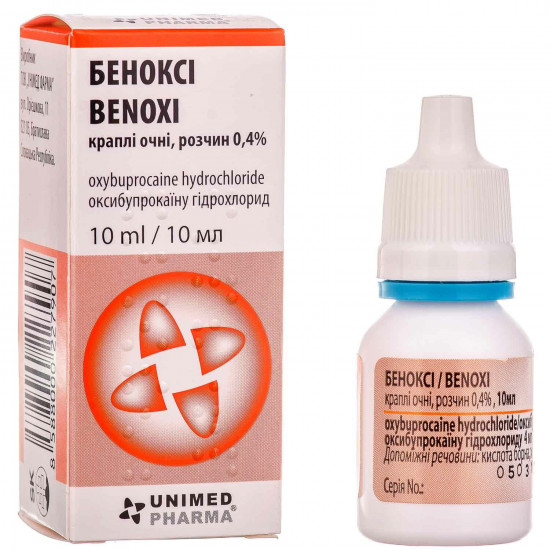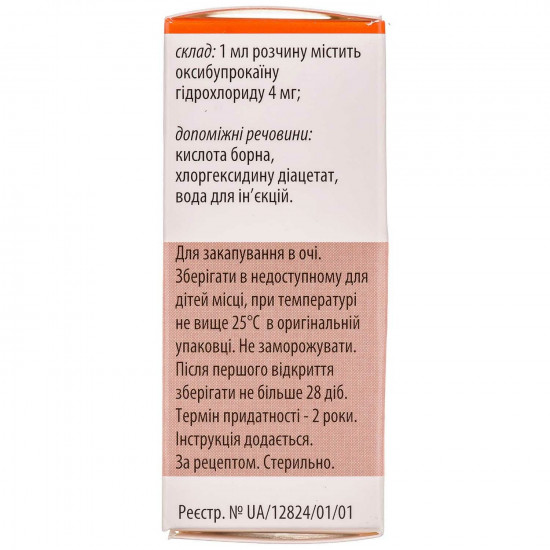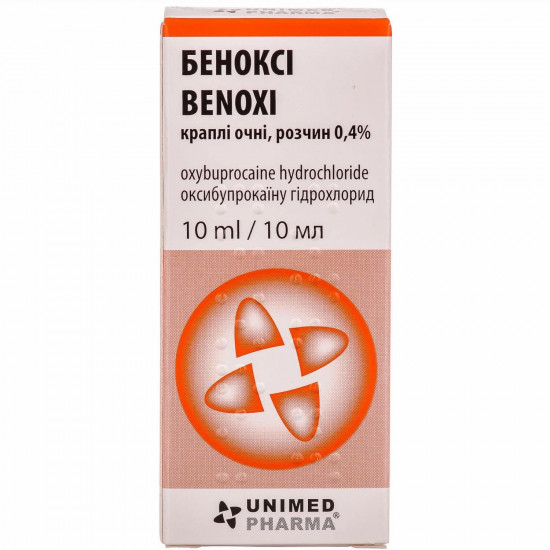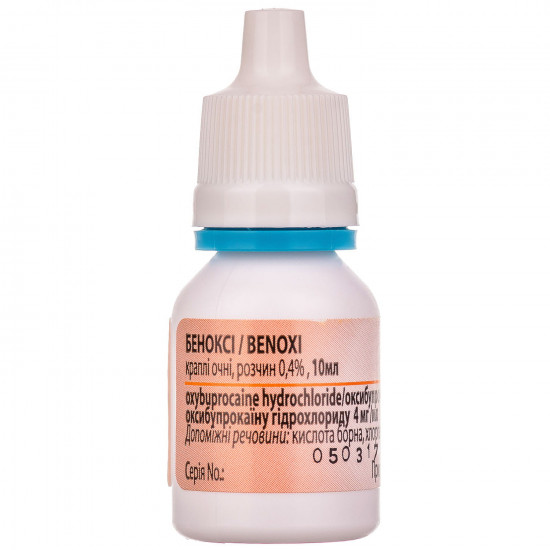







- Stock: In Stock
- Model: 179787
0% Customers recommend this product
-
5 Awesome0%
-
4 Great0%
-
3 Average0%
-
2 Bad0%
-
1 Poor0%
Reviews Over Benoks cap. eye. solution of 0.4% fl. 10 ml
- (0)
Total Reviews (0)
click here write review to add review for this product.
Report this review.
Description
Benoksi medicine is applied to local short-term anesthesia of a cornea and a conjunctiva:
- during removal of foreign debris from a cornea and a conjunctiva;
- carrying out ophthalmotonometry, gonioskopiya and other diagnostic inspections;
- preparation for subconjunctival and retrobulbar injections.
Structure
Active ingredient - an oksibuprokaina a hydrochloride (1 ml of solution supports an oksibuprokain of a hydrochloride of 4 mg).
Excipients: boric acid, a chlorhexidina diacetate, water for injections.
Contraindication
- hypersensitivity to active ingredient or other components of medicine;
- expressed heart failure;
- thyrotoxicosis;
- open getting wounds of an eye;
- hypersensitivity to other local anesthetics of group of PABK esters or groups of amides;
- infection of eyes;
- allergic reactions.
by
for adults and children of 2 years.
to Dig inin a conjunctival sac. Between consecutive burying medicine of an eye have to be closed.
Anesthesia of a cornea and conjunctiva:
- removal of the foreign debris which are contained on a surface - are dug in by 3 times on one drop with an interval of 5 minutes;
- removal of the foreign debris which are contained deeply - 5-10 times on one drop with an interval of 30-60 seconds.
Before carrying out subconjunctival or a retrobulbar injection: 3 times on one drop with an interval of 5 minutes.
Ophthalmotonometry, gonioskopiya and other researches: 1-2 drops once.
As well as when using any eye drops, it is recommended to press easily the site of a dacryocyst in an internal corner of an eye and to release it in one minute for decrease in system absorption. It is necessary to do it right after burying each drop.
Before application of eye drops should remove contact lenses; they can be dressed again after effect of anesthesia completely ends.
At application of two and more ophthalmologic means the interval between their introduction has to make not less than 5 minutes.
Pregnant
Safety of use of medicine is not established to pregnant women by
Feature of application
. Drug can be used during pregnancy only if, according to the doctor, the expected advantage for mother exceeds potential risk for a fruit. Does not know towhether the oksibuprokaina a hydrochloride gets into breast milk. Women can apply "Benoks" during feeding by a breast only if, according to the doctor, the expected advantage for mother exceeds potential risk for the baby.
Children Drug is not intended toby
for application for children up to 2 years.
byDrivers
As oksibuprokain after local introduction to a conjunctival sac it is soaked up, though in a small amount, in blood, system effects can develop. Considering the aforesaid, to steer motor transport, to work with mechanisms or it is possible to work at height not earlier than in 1 hour after application of drops and after recovery of sight.
Overdose
At application of excess doses or at prolonged use, system side reactions can develop. The system toxicity influences, in particular, the central nervous system and a cardiovascular system. Irritability, insomnia, a sedation, confusion of consciousness, excitement, euphoria, a disorientation, disorder of hearing, sight or speech, paresthesia, nausea, vomiting, twitching of muscles, spasms, respiratory violations, a coma, tachycardia, arrhythmia, hypotonia, shock and a stop of warm activity demand symptomatic treatment. Specific antidote is unknown.
Side effects
from organs of sight: after burying medicine there can be a temporary feeling of pricking and burning, reddening, discomfort, usually quickly disappear. Development of allergic reactions a century and conjunctivas is possible. As a result of prolonged or frequent use can develop: stromal infiltration, swelled, moderated damages of a corneal epithelium, a keratitis (including toxic, superficial melkopyatnisty, discal, superinfectious candidosis), L-L factors of an iris of the eye, periorbital contact dermatitis (including allergic), oppression of a precorneal film (only for blue eyes), change of thickness of a cornea, decrease in sensitivity of a cornea, a keratopathy (including striped, violent, a keratopathy, a toxic keratopathy, a necrotic ulcer keratopathy, a postoperative keratopathy), wrinkling of a descemete cover of an eye, increase in sizes of endothelial cells, restriction of raying of an iris of an eye, decrease in density of endothelial cells, an extracellular melanosoma, the subsequent decrease in normal cytokinetic and mitotic activity in cells of an eye, formation of peripheral rings on a cornea, development of tolerance, damage of epithelial cells, irreversible superficial damage of cages at the level of cells of an endothelium of a cornea, direct cytotoxic action on cornea cells (including significant decrease in consumption of oxygen a cornea epithelium), hemoz, development hypopyon or perforation of a cornea, necrosis of a cornea or conjunctiva. Appearance of helcomas, recurrent helcomas, delay of healing of a cornea, its irreversible turbidity, decrease in intraocular pressure, decrease in frequency of spontaneous blinking, the spontaneous movements of eyes, false positive reactions, reduction of stability of a plaintive film, a cataract is possible. Cases of a fibrinous iritis were recorded.
from a cardiovascular system: bradycardia.
from nervous system: a sedation, confusion of consciousness, excitement, euphoria, a disorientation, disorder of hearing, sight or speech, paresthesia, muscular spasms, a loss of consciousness, and at heavy overdose - spasms, an apnoea, a coma.
from digestive tract: nausea, vomiting, dysphagy.
from the immune system: allergic reactions, including an itch, hyperaemia, swelled a century, a contact allergy, a small tortoiseshell, a Quincke's edema, a Quincke's disease, an acute anaphylaxis.
Storage conditionsto Store
in original packing at a temperature not above 25 °C, out of children's reach. Not to freeze.
Expiration date - 2 years.
to storeAfter opening no more than 28 days.
Specifications
| Characteristics | |
| Active ingredients | Oksibuprokain hydrochloride |
| Amount of active ingredient | 4 mg/ml |
| Applicant | Unimed Pharma |
| Code of automatic telephone exchange | S01HA02 Oksibuprokain |
| Interaction with food | It doesn't matter |
| Light sensitivity | Not sensitive |
| Market status | The branded generic |
| Origin | Chemical |
| Prescription status | According to the prescription |
| Primary packing | container |
| Producer | UNIHONEY OF LTD COMPANY OF PHARM |
| Quantity in packing | 10 ml |
| Release form | eye drops |
| Route of administration | Eye |
| Sign | Import |
| Storage temperature | from 15 °C to 25 °C |
| Trade name | Benoks |














































